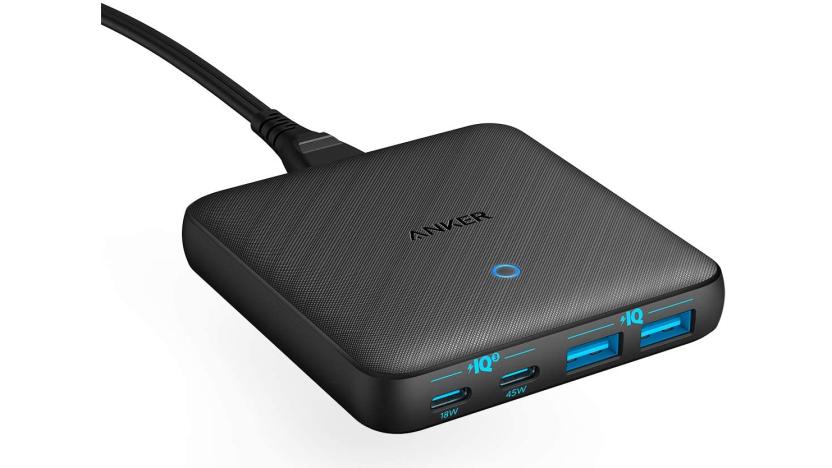GaN
Latest

Anker GaN chargers are up to 43 percent off in Amazon sale
It's a good opportunity to pick up a fast charger if you skipped Amazon's October Prime Day.

Free AI tool restores old photos by creating slightly new loved ones
A recent AI tool can restore vintage photos in a few seconds, and for free.

Anker's third-gen GaN chargers have improved temperature monitoring
The initial lineup of GaNPrime devices features six products, including a power bank.

Meta's 'Make-A-Scene' AI blends human and computer imagination into algorithmic art
On Tuesday, Meta revealed that it has developed an AI image generation engine, dubbed "Make-A-Scene", that it hopes will lead to immersive worlds in the Metaverse and the emergence of digital high art.

OpenAI's DALL-E 2 produces fantastical images of most anything you can imagine
On Wednesday, the OpenAI consortium unveiled DALL-E 2, a higher-resolution and lower-latency sequel to its image-generation-from-a-text-description machine learning system.

Harman gets into charging with its InfinityLab line
Samsung's announced the launch of InfinityLab, a new brand under which it plans to sell a line of "sustainable" wall chargers, power banks and cables.

Several Anker charging gizmos hit record low prices for Prime Day
A GaN fast charging hub is down from $61 to $39.

Tool around in a real-time generated AI version of 'GTAV'
YouTuber Harrison Kinsley shared a video on GAN Theft Auto, an AI that can generate a playable stretch of Grand Theft Auto V’s gameworld on its own.

Razer made a tiny 130W GaN charger that costs $180
Measuring in at 3.2 by 7.7 by 6.2 mm, Razer's new GaN power adapter is small enough to fit in your pocket.

Anker's second-gen GaN chargers are smaller and more efficient
The GaN Nano II devices can charge the M1 MacBook Pro at full speed.

Will gallium nitride electronics change the world?
The semiconductor GaN has already changed the world once, it's at the heart of blue and white LEDs, but researchers are looking at how this materials could revolution power systems, space travel, telecommunications, and even processors.

NVIDIA's AI built Pac-Man from scratch in four days
Pac-Man is 40 today. To celebrate, NVIDIA trained an AI to recreate the game in its entirety based solely off it watching another AI play.

Oppo's next phone can be fully charged in just 30 minutes
While a handful of recent flagship phones -- namely Samsung's Note 10+ (with the optional 45W adapter) and Vivo's NEX 3 5G -- can be fully charged in a little over an hour, Oppo's upcoming tech will soon render such "fast" charging speeds obsolete. We're talking about juicing up a 4,000mAh battery in just 30 minutes! That's the claim for Oppo's 65W SuperVOOC 2.0 feature, which will debut on the gaming-centric Reno Ace due October 10th, according to the company's Shenzhen event yesterday.

MIT made an AI that can detect and create fake images
Creating digital renderings and editing images can take hours, but researchers from MIT and IBM want to change that. They've trained AI to generate photographic images from scratch and to intelligently edit objects inside them. While this could be beneficial for artists and designers, it also offers insight into how neural networks learn context, and the team hopes to leverage the tool to spot fake or altered images.

2018 is the year AI got its eyes
Computer scientists have spent more than two decades teaching, training and developing machines to see the world around them. Only recently have the artificial eyes begun to match (and occasionally exceed) their biological predecessors. 2018 has seen marked improvement in two areas of AI image processing: facial-recognition technology in both commerce and security, and image generation in -- of all fields -- art.

Neural network creates photo-realistic images of fake celebs
While Facebook and Prisma tap AI to transform everyday images and video into flowing artworks, NVIDIA is aiming for all-out realism. The graphics card-maker just released a paper detailing its use of a generative adversarial network (GAN) to create high-definition photos of fake humans. The results, as illustrated in an accompanying video, are impressive and creepy in equal measure.

Artistic AI paints portraits of people who aren't really there
Mike Tyka paints the portraits of people who don't exist. The subjects of his ephemeral artwork are not born from any brush. Rather, they are sculpted -- roughly -- from the digital imagination of his computer's neural network.

Sony, Sumitomo push laser projectors forward with a new, more powerful green laser diode
As cool as lasers are, so far there are precious few commercially available display devices available that use them. That may change with this new green semiconductor laser diode announced by Sony and Sumitomo, capable of the brightness necessary to replace the more expensive light sources used to fill in the middle of the RGB setup. According to the two companies, it's the world's first one capable of over 100mW power at 530nm, which they think will make it a fit for both advanced projectors and compact light projectors. Check after the break for more details on how the technology came to be -- drawing heavily on Sumitomo's production techniques and Sony's GaN laser technology developed with Blu-ray -- we'll let you know when there's a LaserVue or REDray setup priced for general consumption.

NC State patents multifunctional smart sensors, looks to 'revolutionize energy and communications infrastructure'
Bold words coming from a program that choked in epic fashion this past Saturday in front of 58,000+, don't you think? Thankfully for those who are actually involved in the global energy and communications infrastructure (not to mention depressed alumni), NC State's athletics department is far removed from its research labs, and the university's latest development was born and bred in the latter. A team of researchers have managed to patent a new technology that is expected to enable the development of "high-power, high-voltage and high-current devices that are critical for the development of energy distribution devices, such as smart grid technology and high-frequency military communications." The secret? Integrating gallium nitride (GaN) sensors and devices directly into silicon-based computer chips, a feat that hasn't been accomplished by any team prior. According to Dr. Jay Narayan, this newfangled integration has "enabled the creation of multifunctional smart sensors, high-electron mobility transistors, high-power devices, and high-voltage switches for smart grids," and it also makes a broader range of radio frequencies available -- something that'll obviously be beneficial in the advancement of communications. Best of all, a US-based corporation is already in the process of licensing the technology, so it's likely that we'll see this in use in the not-too-distant future. An ACC championship, however, remains far more elusive.

Glowing nanowires could light up your life, one particle at a time
A gadget without LEDs is like hug without a squeeze or apple pie without cheese -- no blinkenlights no care. But, what about nanoscale gadgets? Previously things that were smaller than LEDs naturally couldn't offer their charming glow, but now nanobots too can assault your rods, cones, and good taste thanks to a new process of creating "nano-LEDS" developed by Babak Nikoobakht and Andrew Herzing at NIST. They're really just nanowires, but these have a very different composition than usual due to their method of creation: growing horizontally like vines instead of vertically like trees. By growing them along a gallium nitride surface the wire partially picks up that substance's composition and, with the addition of a little electric current, that GaN infusion causes the wires to glow. Appropriate, that, since gallium nitride is also used in the production of normal-sized LEDs. And thus, the science comes full-circle.










